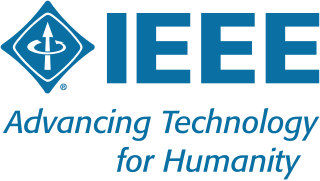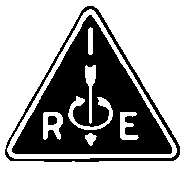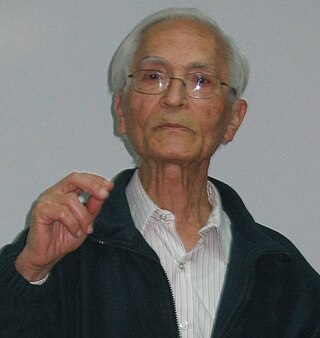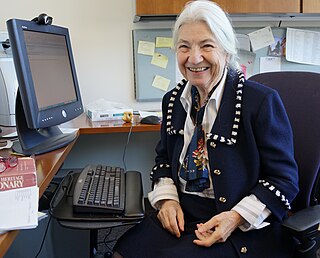
Charles Proteus Steinmetz was an American mathematician and electrical engineer and professor at Union College. He fostered the development of alternating current that made possible the expansion of the electric power industry in the United States, formulating mathematical theories for engineers. He made ground-breaking discoveries in the understanding of hysteresis that enabled engineers to design better electromagnetic apparatus equipment, especially electric motors for use in industry.

IEEE 802 is a family of Institute of Electrical and Electronics Engineers (IEEE) standards for local area networks (LANs), personal area networks (PANs), and metropolitan area networks (MANs). The IEEE 802 LAN/MAN Standards Committee (LMSC) maintains these standards. The IEEE 802 family of standards has had twenty-four members, numbered 802.1 through 802.24, with a working group of the LMSC devoted to each. However, not all of these working groups are currently active.

The Institute of Electrical and Electronics Engineers (IEEE) is an American 501(c)(3) professional association for electronics engineering, electrical engineering, and other related disciplines.

The Institute of Radio Engineers (IRE) was a professional organization which existed from 1912 until December 31, 1962. On January 1, 1963, it merged with the American Institute of Electrical Engineers (AIEE) to form the Institute of Electrical and Electronics Engineers (IEEE).
Broadcast engineering or radio engineering is the field of electrical engineering, and now to some extent computer engineering and information technology, which deals with radio and television broadcasting. Audio engineering and RF engineering are also essential parts of broadcast engineering, being their own subsets of electrical engineering.
The American Institute of Electrical Engineers (AIEE) was a United States-based organization of electrical engineers that existed from 1884 through 1962. On January 1, 1963, it merged with the Institute of Radio Engineers (IRE) to form the Institute of Electrical and Electronics Engineers (IEEE).

Jacob Ziv was an Israeli electrical engineer and information theorist who developed the LZ family of lossless data compression algorithms alongside Abraham Lempel.

Jun-ichi Nishizawa was a Japanese engineer and inventor. He is known for his electronic inventions since the 1950s, including the PIN diode, static induction transistor, static induction thyristor, SIT/SITh. His inventions contributed to the development of internet technology and the information age.
Charles Francis Avila was an American electrical engineer and a Vice President and a member of the Executive Committee of the Yankee Atomic Electric Company.
The IEEE Edison Medal is presented by the Institute of Electrical and Electronics Engineers (IEEE) "for a career of meritorious achievement in electrical science, electrical engineering, or the electrical arts." It is the oldest medal in this field of engineering. The award consists of a gold medal, bronze replica, certificate, and honorarium. The medal may only be awarded to a new leap/breakthrough in the technological area of science.

The IEEE Medal of Honor is the highest recognition of the Institute of Electrical and Electronics Engineers (IEEE). It has been awarded since 1917, when its first recipient was Major Edwin H. Armstrong and is given for an exceptional contribution or an extraordinary career in the IEEE fields of interest. The award consists of a gold medal, bronze replica, certificate, and honorarium. The Medal of Honor may only be awarded to an individual.
The initially called AIEE Lamme Medal was established in 1924 by the American Institute of Electrical Engineers (AIEE) to recognize members for 'meritorious achievement in the development of electrical apparatus or machinery.' The medal was named in recognition of Benjamin G. Lamme, Westinghouse' chief engineer, who amongst others was responsible for the construction of the Niagara Falls generators.
IEEE Transactions on Communications is a monthly peer-reviewed scientific journal published by the IEEE Communications Society that focuses on all aspects of telecommunication technology, including telephone, telegraphy, facsimile, and point-to-point television by electromagnetic propagation. The editor-in-chief is George K. Karagiannidis. According to the Journal Citation Reports, the journal has a 2022 impact factor of 8.3.

μT-Kernel is a real-time operating system (RTOS) designed for 16- and 8-bit microcontrollers. μT-Kernel was standardized by T-Engine Forum and later by the Institute of Electrical and Electronics Engineers (IEEE) IEEE Standards Association as the basis of IEEE 2050–2018.

Ruzena Bajcsy is an American engineer and computer scientist who specializes in robotics. She is professor of electrical engineering and computer sciences at the University of California, Berkeley, where she is also director emerita of CITRIS.
The IEEE Photonics Society, formerly the IEEE Lasers and Electro-Optics Society (LEOS), is a society of the Institute of Electrical and Electronics Engineers (IEEE), focused on the scientific and engineering knowledge about the field of quantum electronics. In the hierarchy of IEEE, the Photonics Society is one of the close to 40 technical societies organized under the IEEE Technical Activities Board.
The Proceedings of the IEEE is a monthly peer-reviewed scientific journal published by the Institute of Electrical and Electronics Engineers (IEEE). The journal focuses on electrical engineering and computer science. According to the Journal Citation Reports, the journal has a 2017 impact factor of 9.107, ranking it sixth in the category "Engineering, Electrical & Electronic." In 2018, it became fifth with an enhanced impact factor of 10.694.
Ernst Weber, Austria-born American electrical engineer, was a pioneer in microwave technologies and played an important role in the history of the New York University Tandon School of Engineering, where in 1945 he founded the Microwave Research Institute. Weber was also the first president of the Institute of Electrical and Electronics Engineers (IEEE) and one of the founders of the U.S. National Academy of Engineering (NAE).
Emmett Finley Carter was an electrical engineer that worked at several companies; most notably, he was in upper management of Sylvania Electric Products and was the director, and later president, of SRI International from 1956 to 1963.
Ranjan Kumar Mallik is an Indian electrical and communications engineer and a professor at the Department of Electrical Engineering of the Indian Institute of Technology, Delhi. He held the Jai Gupta Chair at IIT Delhi from 2007 to 2012 and the Brigadier Bhopinder Singh Chair from 2012 to 2017. He is known for his researches on multiple-input multi-output systems and is an elected fellow of all the three major Indian science academies viz. Indian Academy of Sciences, Indian National Science Academy, and The National Academy of Sciences, India. He is also an elected fellow of The World Academy of Sciences, Indian National Academy of Engineering, and The Institute of Electrical and Electronics Engineers, Inc.








